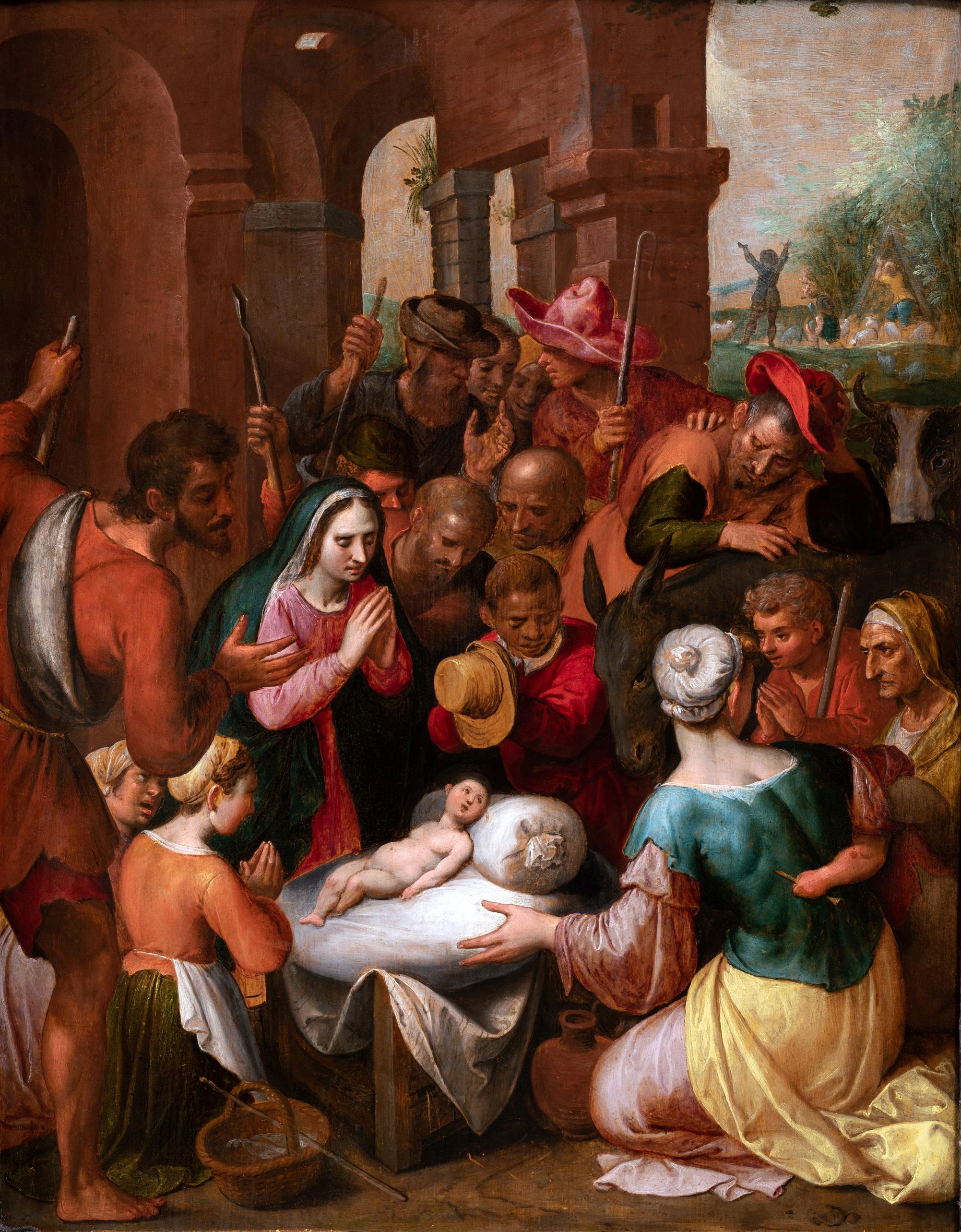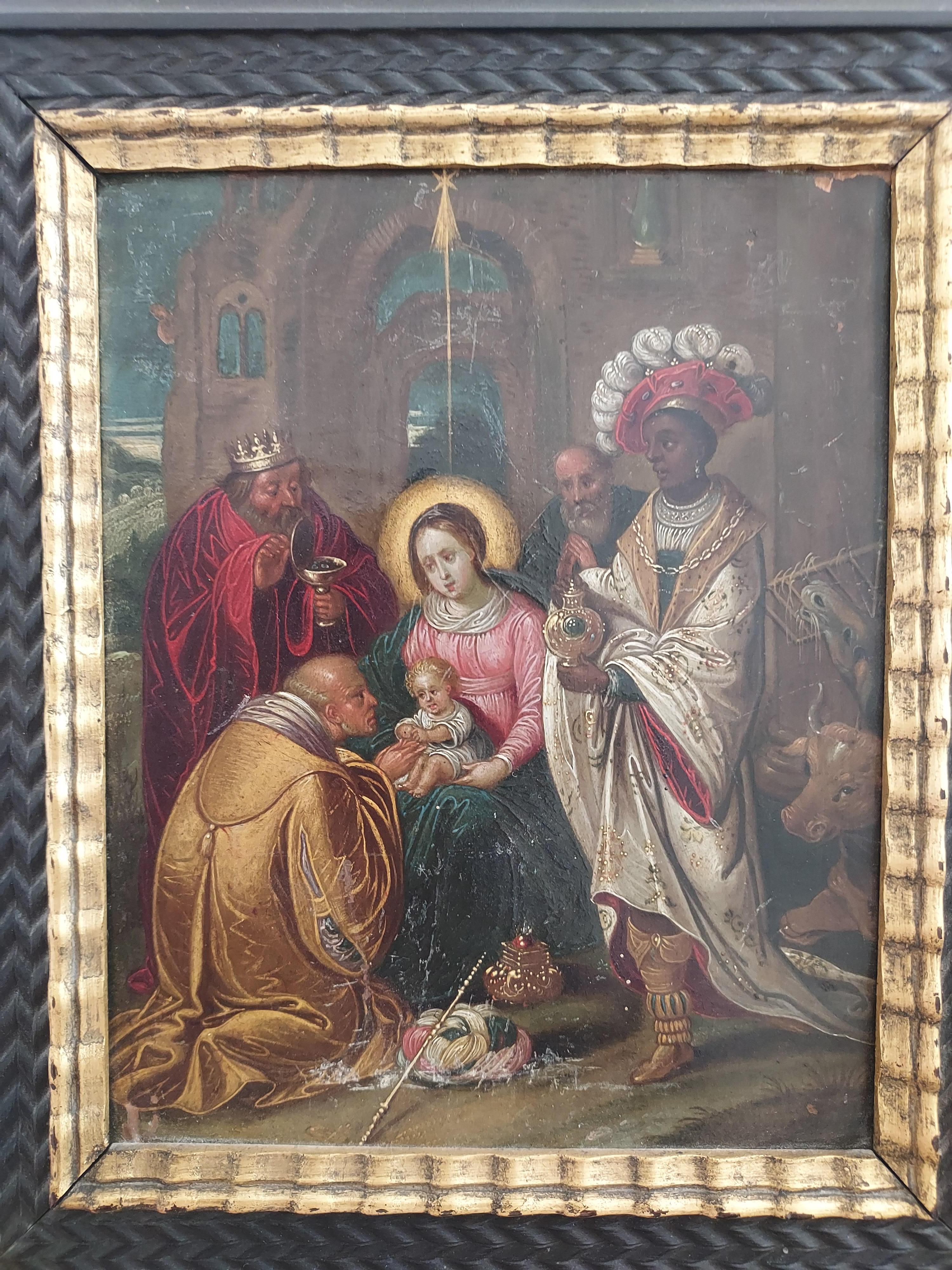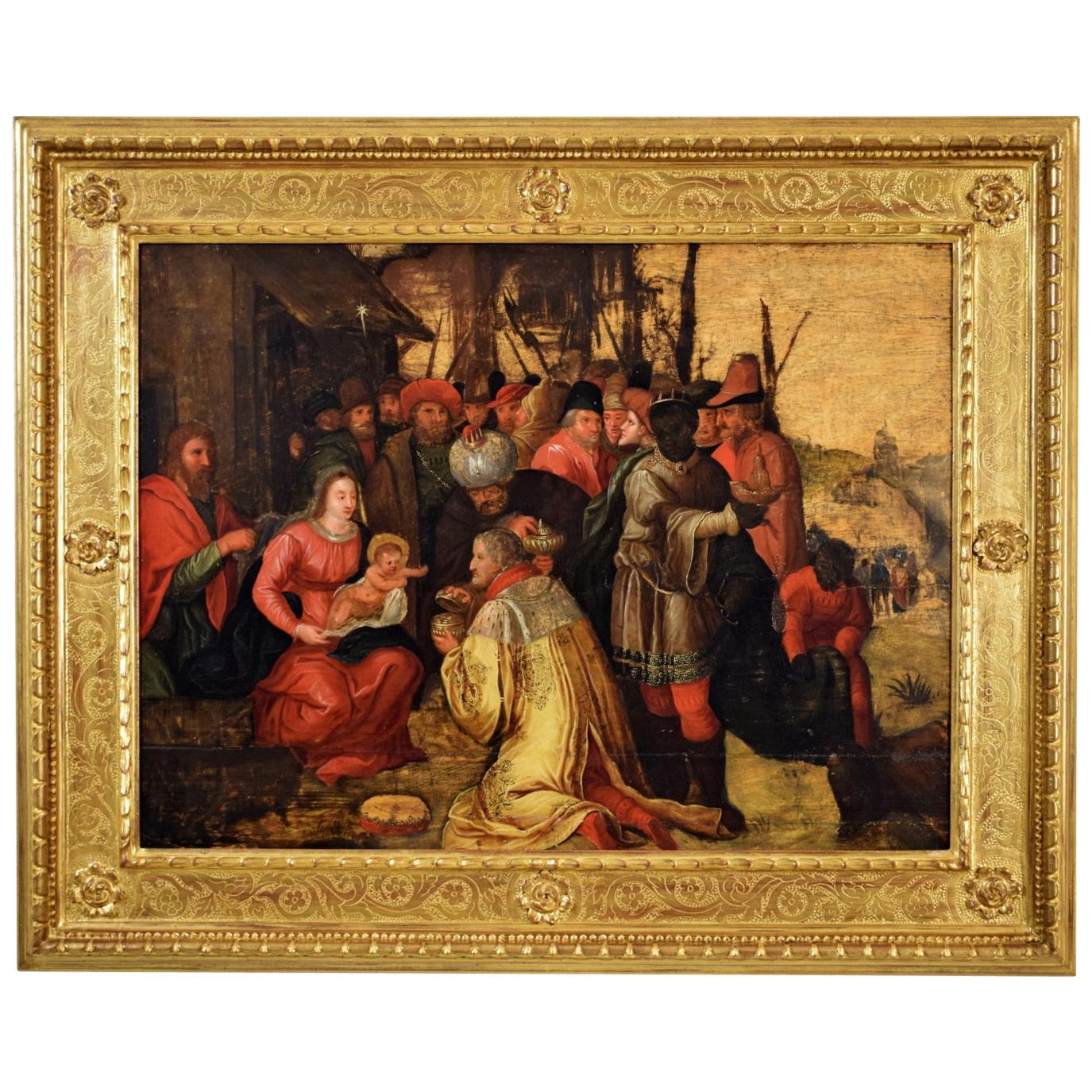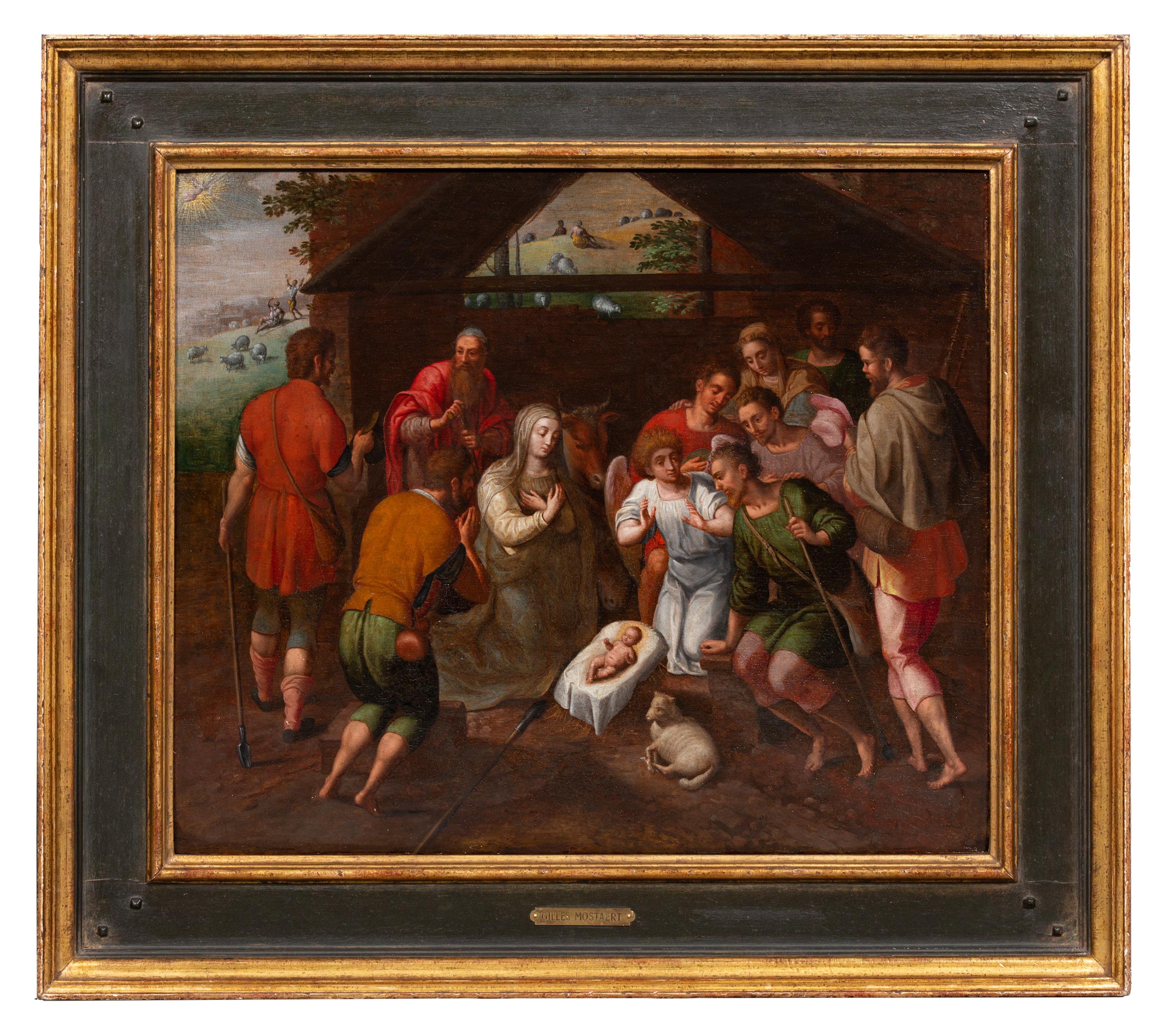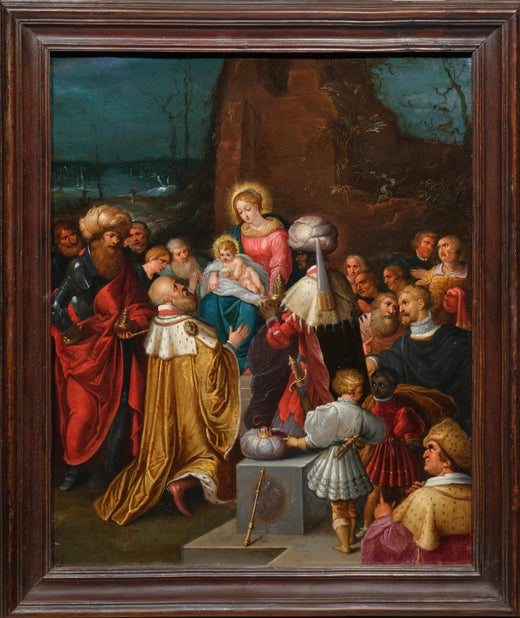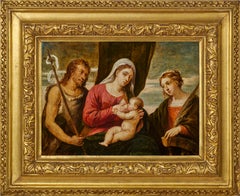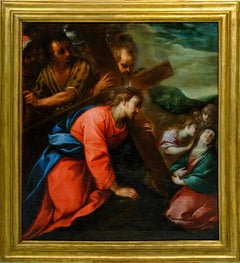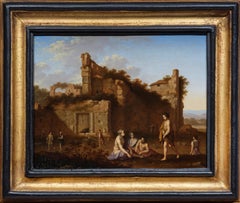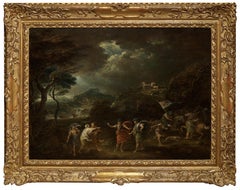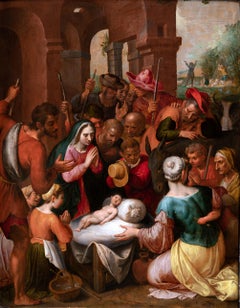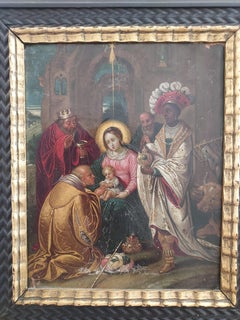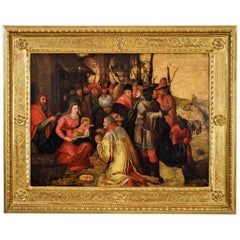Items Similar to The Adoration of the Magi, an early painting by Frans Francken II (1581 - 1682)
Video Loading
Want more images or videos?
Request additional images or videos from the seller
1 of 18
Frans Francken IIThe Adoration of the Magi, an early painting by Frans Francken II (1581 - 1682)ca. 1610
ca. 1610
$74,050.31
£55,061.22
€62,000
CA$104,007.21
A$114,504.21
CHF 58,523.37
MX$1,366,638.72
NOK 745,127.23
SEK 697,272.96
DKK 472,365.95
About the Item
We would like to thank Dr. Ursula Härting who, after examining the work, confirmed the autograph nature of this painting by Frans Francken the Younger in a certificate issued on December 9, 2024.
In this previously unpublished painting coming from a French private collection, Frans Francken the Younger tackles one of his favorite themes: the adoration of the Magi, the wise men who come from the East to adore the infant Jesus in Bethlehem, Judea. This theme was often taken up by the artist, but this version, which can be dated around 1610, is one of the earliest interpretations.
1. Frans Francken the Younger, "a surprisingly inventive painter".
Frans Francken the Younger is the best-known member of an extended artistic family that worked in Antwerp from the late sixteenth to the late seventeenth century. Born in 1581, he almost certainly studied with his father, Frans Francken the Elder (c. 1542-1616), before becoming a master in the Antwerp Saint Luke's Guild in 1605. In 1627 he became a member of the Antwerp archers' guild De Oude Handboog.
Francken was an extremely productive and imaginative artist who specialized in expressively rendered small-scale religious and mythological scenes. He also painted larger altarpieces for Catholic churches. His depictions of collectors' cabinets introduced a genre of painting that influenced several artists, including Jan Brueghel the Elder and David Teniers the Younger. Francken ran a large and productive workshop, where he was assisted by a number of pupils, including his sons Frans III (1607-1667), Hieronymus III (1611-after 1661), and Ambrosius III (c. 1614-1662). Also active in his studio were his brothers Thomas (1574-c. 1626), Hieronymus the Younger (1578-1623), and Ambrosius the Younger (c. 1590-1632). Francken painted many works for the art dealer Christian van Immerzeel, who sold them to Spanish collectors.
Francken frequently collaborated with other artists. For example, he painted figures in landscapes by Abraham Govaerts (1589-1626) and Joos de Momper II (1564-1635) and in architectural scenes by Bartholomeus van Bassen (c. 1560-1652) and Peeter Neeffs the Elder. He also collaborated with flower painters, among them Jan Brueghel the Elder, Jan Brueghel the Younger (1601-1678), and Andries Danielsz (active c. 1600-1625).
2. Description of the painting
The scene depicted in our painting is directly inspired by St. Matthew's Gospel (2-1-11), which recounts the arrival of "Magi from the East": " On coming to the house, they saw the child with his mother Mary, and they bowed down and worshiped him. Then they opened their treasures and presented him with gifts of gold, frankincense and myrrh."
The Mother of God is enthroned on a stepped stone pedestal from which she dominates the scene. She presents the divine child on a sheet placed on her lap, in which he lies and looks at the viewer. A winter landscape can be seen in the left background.
Over the centuries, these three characters (whose number derives from the number of gifts offered according to the Gospel) have been known as the Magi, the Wise Men and, since the Middle Ages, as Kings. While the Gospels are silent on their names, they do appear in a 6th-century Greek manuscript that has been adopted into Church tradition: Gaspard, Melchior and Balthasar. Different iconographic traditions are superimposing. A young man, a middle-aged man, and an old man symbolize the three ages of Man. To symbolize the universality of the Church, they also represent the three continents known in the Middle Ages: Europe, Asia and Africa. Balthasar is then represented as an African.
According to Johannes Molanus (1533-1585), the leading Catholic theologian in Flanders at the time of Francken, Gaspard was 60, Balthasar 40 and Melchior 20. This tradition is reflected in our painting. Two of them wear turbans and carry containers of gold and myrrh as gifts. Only the light-skinned king, probably the European, has placed his scepter and turban at the feet of the mother with and her child, and kneels in adoration of the Son of God. But behind his turban rises the smoke from his censer...
The oval medallion adorning the pedestal on which the turban has been placed depicts a horseman, perhaps another reference to the New Testament: the Faithful and True Rider (Revelation 19) who will rule the nations with a rod of iron on the last day. This reference links this scene of adoration with the proclamation of the Salvation at the end of times brought about by Christ.
The three Magi are joined by two pages and several other figures depicted in costumes contemporary with the period in which the painting was made, thus drawing the viewer into the picture. The shimmering colors of the various garments are further enhanced by the use of a gold background to evoke Gaspard's brocade coat.
3. Related artworks
Another autograph version of this composition (last photo in the gallery) is known and was presented in 2008 by the New York gallery Lawrence Steigrad Fine Arts. Very similar to our composition , it differs mainly by the two-tone colors of the turban at the Virgin's feet.
Our composition was also used in several studio versions (in which Gaspard's dress is generally painted in golden yellow rather than with gold). Frans Francken the Younger would later depict this theme again and again, as evidenced by this version dated 1618, sold by Koller in 2011 .
Main bibliographical references
Ursula Härting - Frans Francken der Jüngere - Die Gemälde, Freren 1989
Catalog of the exhibition La Dynastie Francken, Musée de Flandre Cassel 2020
- Creator:Frans Francken II (1581 - 1642, Flemish)
- Creation Year:ca. 1610
- Dimensions:Height: 16.13 in (40.98 cm)Width: 13.88 in (35.26 cm)
- Medium:
- Movement & Style:
- Period:1610-1619
- Condition:13 7/8” x 11 3/8” (35.3 x 28.9 cm) - Framed: 16 1/8” x 13 7/8” (41 x 35.2 cm) Provenance: private collection formed in Orléans (France) at the end of the 19th century Blackened wood frame - 17th century Italy.
- Gallery Location:PARIS, FR
- Reference Number:1stDibs: LU1568215925352
Frans Francken II
Frans Francken the Younger is the best-known member of an extended artistic family that worked in Antwerp from the late sixteenth to the late seventeenth century. Born in 1581, he almost certainly studied with his father, Frans Francken the Elder (c. 1542-1616), before becoming a master in the Antwerp Saint Luke's Guild in 1605. In 1627 he became a member of the Antwerp archers' guild De Oude Handboog. Francken was an extremely productive and imaginative artist who specialized in expressively rendered small-scale religious and mythological scenes. He also painted larger altarpieces for Catholic churches. His depictions of collectors' cabinets introduced a genre of painting that influenced several artists, including Jan Brueghel the Elder and David Teniers the Younger. Francken ran a large and productive workshop, where he was assisted by a number of pupils, including his sons Frans III (1607-1667), Hieronymus III (1611-after 1661), and Ambrosius III (c. 1614-1662). Also active in his studio were his brothers Thomas (1574-c. 1626), Hieronymus the Younger (1578-1623), and Ambrosius the Younger (c. 1590-1632). Francken painted many works for the art dealer Christian van Immerzeel, who sold them to Spanish collectors. Francken frequently collaborated with other artists. For example, he painted figures in landscapes by Abraham Govaerts (1589-1626) and Joos de Momper II (1564-1635) and in architectural scenes by Bartholomeus van Bassen (c. 1560-1652) and Peeter Neeffs the Elder. He also collaborated with flower painters, among them Jan Brueghel the Elder, Jan Brueghel the Younger (1601-1678), and Andries Danielsz (active c. 1600-1625).
About the Seller
5.0
Vetted Professional Seller
Every seller passes strict standards for authenticity and reliability
Established in 2020
1stDibs seller since 2021
10 sales on 1stDibs
- ShippingRetrieving quote...Shipping from: PARIS, France
- Return Policy
Authenticity Guarantee
In the unlikely event there’s an issue with an item’s authenticity, contact us within 1 year for a full refund. DetailsMoney-Back Guarantee
If your item is not as described, is damaged in transit, or does not arrive, contact us within 7 days for a full refund. Details24-Hour Cancellation
You have a 24-hour grace period in which to reconsider your purchase, with no questions asked.Vetted Professional Sellers
Our world-class sellers must adhere to strict standards for service and quality, maintaining the integrity of our listings.Price-Match Guarantee
If you find that a seller listed the same item for a lower price elsewhere, we’ll match it.Trusted Global Delivery
Our best-in-class carrier network provides specialized shipping options worldwide, including custom delivery.More From This Seller
View AllVirgin and Child, a paiting by David Teniers the Younger after Palma Vecchio
By David Teniers the Younger
Located in PARIS, FR
Provenance:
Dukes of Marlborough Collection, Blenheim Palace until its sale at Christie's London on 26 July 1886 (lot 172)
English private collection until its sale at Christie's London on 11 December 1992 (lot 363)
Erna Weidinger Collection (1923 - 2021) - Austria
Literature :
Georg Scharf - A list of the pictures in Blenheim Palace - Catalogue raisonné Part 2 - London 1862 (page 166 - number 199 "after Palma Giovane")
Charles Davies...
Category
1750s Old Masters Figurative Paintings
Materials
Oak, Oil
Christ Falling on the Way to Calvary, a painting by Carlo Francesco Nuvolone
Located in PARIS, FR
This painting by Carlo Francesco Nuvolone, the great Lombard master of the mid-seventeenth century, is striking for its dazzling composition and the brilliant colors of Christ's tuni...
Category
1640s Old Masters Figurative Paintings
Materials
Canvas, Oil
Gathering in antique Ruins, a monogrammed painting by Jan van Haensbergen
By Jan Van Haensbergen
Located in PARIS, FR
Jan van Haensbergen was a painter of the Dutch Golden Age and a pupil of Cornelius van Poelenburgh (Utrecht 1594 - 1667). The painting we are presenting is inspired by Poelenburgh’s landscapes from his Italian sojourn. The dreamlike atmosphere of this Gathering in antique ruins appealed to us. Against a backdrop of antique ruins, three draped characters (perhaps bathers) are sitting in a circle, greeting a fourth character walking towards them.
Their tranquility contrasts with the bustle of the other characters in the background. They constitute a vivid illustration of otium, this leisure time that allows us to realize our full potential. With this Arcadian landscape, Jan van Haensbergen invites us in turn to leave the hustle and bustle of everyday life behind, to take a break, to enjoy the present moment chatting with close friends…
1. Jan van Haensbergen, a landscape and portrait painter of the Dutch Golden Age
Jan van Haensbergen was born in 1642 in Gorinchem, a town in southern Holland to the east of Rotterdam. He was a pupil of Cornelius van Poelenburgh, and began by painting landscapes inspired by those of his master, in an Italianate style. Between 1668 and 1669, he was registered at the Guild of Saint Luke in Utrecht.
In 1669, he moved to The Hague, where he joined the Confrérie Pictura, an artist society founded in 1656. His portraits, which became his main activity as a painter after settling in The Hague, were strongly influenced by Caspar Netscher (Prague or Heidelberg 1639 - The Hague 1684), whom he met in The Hague and whose son Constantijn became his son-in-law by marrying his daughter Magdalena.
In addition to his work as an artist, Van Haensbergen was also an art dealer, probably helped by his appointment as Dean of the Confrérie Pictura, where he also teached.
2. Description of the artwork and related paintings
This painting seems to us to be a kind of allegory of otium, that quiet bliss promised by Epicurus. It might even evoke an Epicurean proverb: "It is better to lie on the naked ground and be at ease, than to have a golden carriage and a rich table and be worried" .
Three draped young people - two men and a woman in the background - are seated in a circle, greeting a fourth figure walking towards them, hair disheveled and body draped in a towel as if drying off after a bath, indicating the need for prior purification to fully enjoy this rest. Their nonchalance contrasts with the bustle of the various characters in the background.
The composition is punctuated by successive diagonals, and opens onto a landscape on the right, with a succession of mountainous planes. This painting is typical of the Italianate works produced by Van Haensbergen in the 1660s under the influence of Cornelis van Poelenburgh...
Category
17th Century Old Masters Landscape Paintings
Materials
Oak, Oil
Macbeth and the Three Witches a Painting on Panel by Francesco Zuccarelli
By Francesco Zuccarelli
Located in PARIS, FR
This painting, created during Zuccarelli's stay in England, represents the decisive moment when Macbeth, together with Banquo, meets the three witches who announce that he will be Ki...
Category
1760s Old Masters Landscape Paintings
Materials
Oil, Wood Panel
From Renaissance Venice to Barocco Naples, a drawing by Francesco La Marra
Located in PARIS, FR
This vigorous drawing presents a brilliant synthesis between the Venetian tradition of Titian, of which it is a distant echo, and the Neapolitan Baroque of Solimena, which strongly i...
Category
Mid-18th Century Old Masters Figurative Drawings and Watercolors
Materials
Paper, Ink, Felt Pen
River Landscape with Shepherds and Architecture, a painting by Jan van Bunnik
By Jan van Bunnik
Located in PARIS, FR
This painting has been the subject of a study by the art historian Fabrizio Dassie (available on request), confirming its inclusion in Jan van Bunnik’s corpus.
In this painting, Ja...
Category
Late 17th Century Old Masters Landscape Paintings
Materials
Copper
You May Also Like
Adoration Magi Jan Van Der Straet Paint Oil on canvas Old master 16th Century
Located in Riva del Garda, IT
Jan Van der Straet, known as Giovanni Stradano (Bruges 1523 - Florence 1605), Workshop of
The Adoration of the Magi
late 16th century - early 17th century
oil painting on canvas
Mea...
Category
16th Century Old Masters Paintings
Materials
Oil
$7,297 Sale Price
20% Off
Cercle of Ambrosius Francken, Adoration of the shepherds, 17th century Antwerp
Located in PARIS, FR
Adoration of the shepherds,
Cercle of Ambrosius Francken,
Early 17th century Antwerp school
Oil on oak panel: h. 55 cm, w. 43 cm (21.65 in x 16.93 in)
17th c. ebonized and moulded f...
Category
Early 17th Century Old Masters Figurative Paintings
Materials
Oil, Wood Panel
The Adoration of the Magi . Flemish School
Located in Pasadena, CA
Oil on cupper and wooden panel . Our tender representation is from the second half of the 17th century , follower of Cornelis de Baellieur School. The adoration of the Magi flemish s...
Category
Early 1600s Flemish School Figurative Paintings
Materials
Oil
Frans Franken III 16th Century Oil on Wood, Adoration of the Magi, Painting
By Frans Franken the Younger
Located in IT
Frans Franken III and aid, Adoration of the Magi
Good condition
The oil painting on wood, with a gold background, depicts an Adoration of the Magi. The Magi are dressed in sumptuous silk and brocade dresses; they wear precious hats and jewelery. The richness of their garments is in contrast with the humility of the Holy Family and of the other characters who, around curious, observe the scene. The hut is simple, made of wood and straw: above it shines the Comet, symbol of the divine event. In the distance, a group of wayfarers walk along a path that is lost on the horizon, blending into the gold of the bottom.
The representation proposes a traditional iconography, in which the painter inserts some details that he lends himself to symbolic interpretations. Among these is the appearance of the Magi, who from the XIVth century differs iconographically: the wise astronomers represent the homage to Jesus of the then known parts of the world, namely Africa, Asia and Europe. To the right of the Magi, in the foreground, sits a monkey, considered a demonic creature and a symbol of lies and sin. It is depicted on the sidelines, as a defeat, next to a fragment of a classical column: ruin alludes to the end of paganism, of the old world that collapses with the advent of the new one, marked by the birth of Christ and liberation from the Original Sin. On the ruins he climbs the ivy, symbol of the immortality of the soul. The work is attributable to the workshop of the Flemish painter Frans Francken III...
Category
Antique 16th Century Belgian Renaissance Paintings
Materials
Paint
Adoration of the Shepherds by Gillis Mostaert (1534 - 1598) Flemish Renaissance
Located in Knokke, BE
Gillis Mostaert
Hulst 1534 – 1598 Antwerp
Flemish Painter
'Adoration of the Shepherds'
Medium: oil on panel
Dimensions: image size 38,5 x 46,5 cm, frame size 54 x 62 cm
Provenance...
Category
16th Century Renaissance Interior Paintings
Materials
Oil, Panel
Frans Wouters, Adoration of The Herders, Christmas Scene, Christ, Flemish School
Located in Greven, DE
Frans Wouters was a Flemish Baroque painter who mainly created smaller cabinet pieces.
He was initially apprenticed to Pieter van Avont in Antwerp, but then moved to Rubens‘ worksho...
Category
17th Century Baroque Figurative Paintings
Materials
Oak, Oil
More Ways To Browse
Paintings Of The Virgin Mary
Antique Scepter
Antique Copper Painting
Antique Autographs
Mother Mary
Oil Painting Of Mary And Jesus
Wise Men
Brother Thomas
Horseman Antique
Adoration Magi
Adoration Of The Magi
Antique Stepping Stones
Christian Dior New York Dress
Gold Brocade Coat
David Elder
Frans Francken The Younger
Antique Picture Viewer
Francesco Albani
